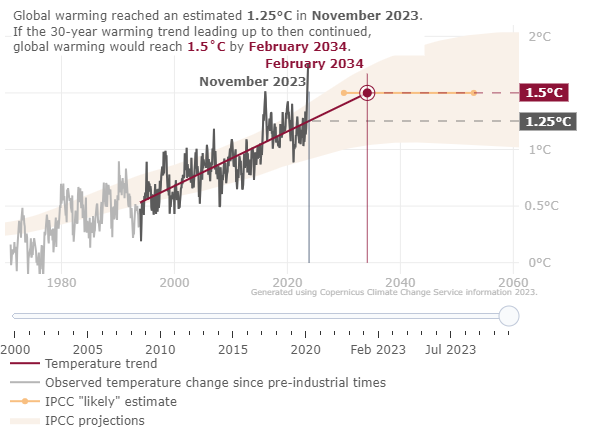All global warming forecasts in 2024
Global warming is accelerating
In 2020 the average temperature of the Planet rose above +1.2°C compared to the pre-industrial period and the scientific community expected that global warming would remain more or less on those values in subsequent years. It did not happen like this: 2023 is closing at almost +1.5°C, between summer and autumn we lived several months over +1.7°C and for a few days in November we also passed the threshold of 2 degrees. Global warming is accelerating. What will happen to global warming in 2024?
2024 will be hotter than 2023: Met Office
According to the British Met Office, global warming in 2024 will exceed this year’s levels. If 2023 is set to become the hottest year ever, beating the records of 2016 and 2020, the next 12 months will be marked by even more marked thermal anomalies.
read also Global warming soars: November to +1.75°C, 2023 is +1.46 ºC
The Met Office forecasts set the global average temperature for 2024 in a range between +1.34 ºC and +1.58 ºC, with a central estimate of +1.46 ºC. “The forecast is in line with the current global warming trend of 0.2 ºC per decade and is reinforced by a significant El Niño event. So, we expect two new record years of global temperature in a row, and for the first time, we predict a reasonable chance that a year will temporarily exceed 1.5 ºC,” argues Nick Dunstone of the Met Office.
El Niño drives global warming again in 2024
A prediction shared by other climate scientists and which affects several factors. On all the influence of the “Child”. By itself, a moderate to strong El Niño event can increase global warming by about 2 tenths of a degree. The current one in recent months is of high intensity and, according to projections, should have reached its peak in recent weeks but its signal – a very marked thermal anomaly in the equatorial Pacific waters – should continue throughout the winter, therefore also in early 2024. Once the “Child” is exhausted, its effects should continue to be felt for a few more months on global temperatures.
Take out 1.5 °C only temporarily?

Global warming levels in 2024 will make the ongoing debate about what it means to exceed the 1.5-degree threshold even more glowing. The most ambitious limit of the Paris Agreement is not broken if the world exceeds that temperature for a single year. And all the most optimistic but at the same time realistic emissive scenarios, which elaborated the latest report of the IPCC speak of a “temporary overshoot” of the threshold of 1.5 degrees: reach that is to 1.6°C (minimum overshoot) or 1.8°C (consistent overshoot) but returning below 1,5 °C before the end of the century.
But when can we say that we have exceeded this limit in the sense of exceeding the Paris Agreement? The scientific community is divided. Some scientists claim that it takes several consecutive years beyond the threshold to talk about overrun. Others, however, believe that we have already crossed the line. Why? The next few years will see global warming levels higher than today’s record. And by calculating the global warming average over 5-10 years, probably the time of overrun will be set around 2023.
“I contend that by next year or two (2024-25) we will rise to 1.6 °C, 1.7 ºC heating. Then, once El Niño is finished, it will come back, but it won’t go down to 1.2 C,” comments James Hansen, one of the pioneers of global warming studies (which some criticize for “catastrophism”). “It could go down to 1.4 ºC or so, but since the planet is so out of balance it won’t go down much. So we are already at the limit of heating of 1.5 °C, and according to my estimate we have more than 2 °C in the yard by the mid and late 30s“.






